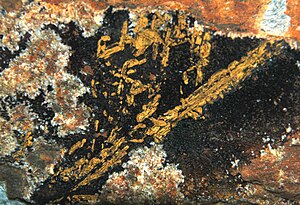
The Colorado School of Mines is a public research university in Golden, Colorado. It is focused on science and engineering, where students and faculty together address the great challenges society faces today−particularly those related to the Earth, energy and environment. In every QS World University Ranking from 2016 to 2019, the university was ranked as the top institution in the world for mineral and mining engineering.

A mining engineer is somebody who is academically accomplished in the engineering discipline of extraction of minerals from underneath the ground, above the ground or on it. Mining engineering is associated with many other disciplines, such as mineral processing, exploration, excavation, geology, and metallurgy, geotechnical engineering and surveying. A mining engineer may manage any phase of mining operations – from exploration and discovery of the mineral resource, through feasibility study, mine design, development of plans, production and operations to mine closure.
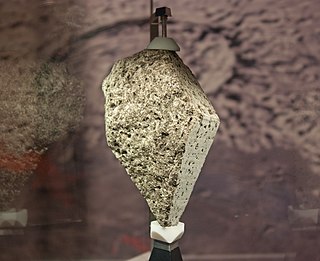
Moon rock or lunar rock is rock that is found on the Earth's Moon including lunar material collected during the course of human exploration of the Moon, or rock that has been ejected naturally from the Moon's surface.
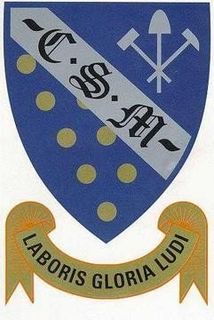
The Camborne School of Mines, commonly abbreviated to CSM, was founded in 1888. Its research and teaching is related to the understanding and management of the Earth's natural processes, resources and the environment. It has undergraduate, postgraduate and research degree programmes within the Earth resources, civil engineering and environmental sectors. CSM is located at the Penryn Campus, near Falmouth, Cornwall, UK. The school merged with the University of Exeter in 1993.
Mineral resource classification is the classification of mineral resources based on an increasing level of geological knowledge and confidence. Mineral deposits can be classified as:

Arthur Lakes was a notable geologist, artist, writer, teacher and minister. He captured much of his geological and palaeontological field work in sketches and watercolours. Lakes is credited with successfully deciphering much of the geology of Colorado and, as an economic geologist, guiding mineral exploration which was so important to the State.

The National Mining Hall of Fame is a museum located in Leadville, Colorado, United States, dedicated to commemorating the work of miners and people who work with natural resources. The museum also participates in efforts to inform the public about the mining industry.

Sweet Home Mine is a mine near Alma, Colorado, United States. It was founded in 1873 as a silver mine. It is best known as the source of the famous rhodochrosite crystals "Alma King", displayed at the Denver Museum of Nature and Science, and "Alma Rose", displayed at the Rice Northwest Museum of Rocks and Minerals in Oregon.

North Table Mountain is a mesa on the eastern flank of the Front Range of the Rocky Mountains of North America. The 6,555-foot (1,998 m) mesa summit is located in North Table Mountain Park, 3.4 miles (5.5 km) north by east of downtown Golden, Colorado, United States, in Jefferson County.

Uranium mining in Colorado, United States, goes back to 1872, when pitchblende ore was taken from gold mines near Central City, Colorado. The Colorado uranium industry has seen booms and busts, but continues to this day. Not counting byproduct uranium from phosphate, Colorado is considered to have the third largest uranium reserves of any US state, behind Wyoming and New Mexico.

Silver mining in Colorado has taken place since the 1860s. In the past, Colorado called itself the Silver state.

Castle Dome Landing, Arizona is a ghost town in the Castle Dome Mountains of Yuma County in the U.S. state of Arizona. It was first settled as a transport depot and mining camp around 1863 in what was then the Arizona Territory.

The Sterling Hill Mine, now known as the Sterling Hill Mine Tour & Museum of Fluorescence, is a former iron and zinc mine in Ogdensburg, Sussex County, New Jersey, United States. It was the last working underground mine in New Jersey when it closed in 1986. It became a museum in 1989. Along with the nearby Franklin Mine, it is known for its variety of minerals, especially the fluorescent varieties. It was added to the National Register of Historic Places in 1991.

The Golden Fleece Mine is a gold mining site in Hinsdale County, Colorado, 5 miles (8 km) south of Lake City. The mine is located half a mile west of the north end of Lake San Cristobal. By 1904 it had produced $1,400,000 in silver and gold ore. The mine operated intermittently until 1919. Later, in the mid-1960s, some renewed interest in the property came up, especially in the Hiwassee lode area of the mine, but other than a couple of small test shipments, there is no recorded production until today.
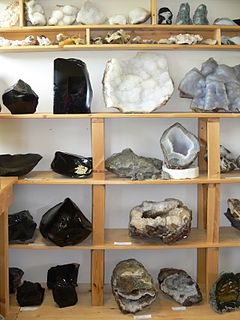
Mineral collecting is the hobby of systematically collecting, identifying and displaying mineral specimens. Mineral collecting can also be a part of the profession of mineralogy and allied geologic specialties. Individual collectors often specialize, for example collecting examples of the various colors and forms taken by the mineral calcite, calcite from widely scattered locations in a region or the world, or minerals found in pegmatites.

The Cripple Creek & Victor Gold Mine, formerly and historically the Cresson Mine, is an active gold mine located near the town of Victor, in the Cripple Creek mining district in the US state of Colorado. The richest gold mine in Colorado history, it is the only remaining significant producer of gold in the state, and produced 322,000 troy ounces of gold in 2019, and reported 3.45 million troy ounces of Proven and Probable Reserves as at December 31, 2019. It was owned and operated by AngloGold Ashanti through its subsidiary, the Cripple Creek & Victor Gold Mining Company (CC&V), until 2015, when it sold the mine to Newmont Mining Corporation.

The Colorado lunar sample displays are two commemorative plaques consisting of small fragments of Moon specimen brought back with the Apollo 11 and Apollo 17 lunar missions and given in the 1970s to the people of the state of Colorado by United States President Richard Nixon as goodwill gifts.

The Illinois lunar sample displays are two commemorative plaques consisting of small fragments of Moon specimen brought back with the Apollo 11 and Apollo 17 lunar missions and given in the 1970s to the people of Illinois by United States President Richard Nixon as goodwill gifts.

Pikeview is a neighborhood of Colorado Springs, annexed to the city as the "Pike View Addition" on August 1, 1962. In 1896 there was a Denver and Rio Grande Western Railroad station in Pikeview, and miners had begun digging a shaft for the Pikeview Coal Mine. Pikeview also had a quarry beginning 1905 for the mining of limestone for concrete. Coal mining ended in 1957, but the Pikeview Quarry continues to operate. Quarry operations, though, have created a gash or scar in the landscape and efforts have been made since the late 1980s to reclaim the hillside landscape. The Greg Francis Bighorn Sheep Habitat in what had been Queens Canyon Quarry was founded in 2003 in recognition of the individuals and organizations that have worked to create a nature hillside habitat.
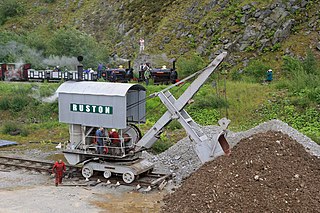
The Threlkeld Quarry and Mining Museum is located in Threlkeld three miles (4.8 km) east of Keswick, in the heart of the Lake District in Cumbria. It is suited for families, school classes and enthusiasts. It includes a quarry with a unique collection of historic machinery, such as locomotives and cranes, an underground tour of a realistic mine, a comprehensive geological and mining museum and mineral panning.


